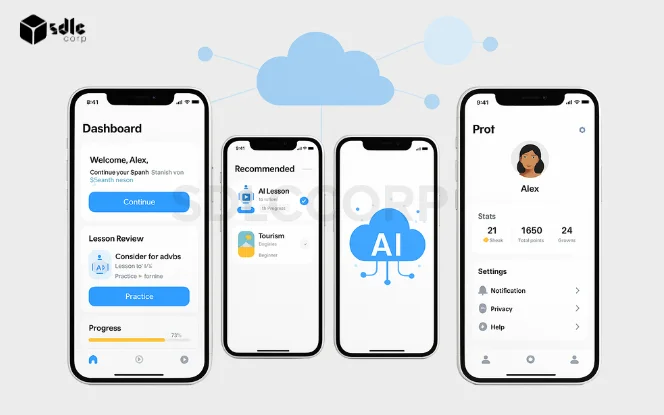Introduction
Understanding the Language Learning App Market

- Rising demand for digital education in multilingual regions
- Mobile-first users prefer flexible, bite-sized language lessons
- Gamification increases retention and learning outcomes
- High ROI potential via subscriptions, freemium models, and in-app ads
- Duolingo’s success validates the market demand and monetization strategy
Key Features of a Duolingo-like App
1. Interactive Lessons

Deliver bite-sized, adaptive lessons that cater to individual proficiency levels, ensuring personalized and effective learning experiences.
- Adaptive algorithms tailor content to user performance.
- Incorporation of multimedia elements for diverse learning styles.
- Real-time feedback enhances comprehension and retention
Explore insights on creating engaging and educational content for younger audiences in the article on Android Games for Kids: Safety and Educational Value.
2. Gamification Elements

Incorporate game-like features such as badges, leaderboards, and streaks to motivate users and enhance engagement.
- Reward systems encourage consistent usage.
- Leaderboards foster healthy competition among users.
- Progress tracking maintains user motivation.
3. Speech Recognition

Enable users to practice pronunciation through integrated speech recognition technology, enhancing speaking skills.
- Real-time pronunciation feedback.
- Voice input for interactive exercises.
- Supports multiple accents and dialects.
4. Progress Tracking
- Dashboards displaying completed lessons and achievements.
- Goal-setting features to encourage consistent learning.
- Analytics to monitor improvement over time.
5. AI-Powered Personalization

Utilize artificial intelligence to tailor lesson plans based on individual user performance, preferences, and learning pace, enhancing engagement and effectiveness.
- Adaptive learning paths that adjust to user progress.
- Personalized content recommendations to reinforce weak areas.
- Predictive analytics to anticipate user needs and challenges.
Want to understand how personalized learning works behind the scenes? Explore the foundations of AI in our detailed guide on What is Generative AI?
6. Profile and Settings

Allow users to create and manage personal profiles, customize learning preferences, and adjust app settings for a tailored experience.
- Personalized dashboards displaying progress and achievements.
- Customization options for learning goals and notification preferences.
- Privacy settings to control data sharing and visibility.
7. Push Notifications

Implement timely reminders and motivational messages to encourage consistent learning habits and re-engage inactive users.
- Daily lesson reminders to maintain learning streaks.
- Alerts for new course availability and achievements.
- Personalized messages based on user activity and preferences.
8. Courses and Levels

Offer structured courses segmented into levels, enabling users to progress from basic to advanced proficiency systematically.
- Diverse language courses catering to various proficiency levels.
- Progressive unlocking of advanced content upon level completion.
- Assessment tests to determine appropriate starting levels.
9. Language Practice and Revision

Enable users to reinforce their learning through regular practice sessions and revision exercises tailored to their progress.
- Spaced repetition systems to optimize memory retention.
- Customized practice sessions focusing on weak areas.
- Interactive quizzes and flashcards for effective revision.
10. Social Media Integration

Facilitate seamless login, sharing of achievements, and community engagement through integration with popular social media platforms.
- Social login options for quick and easy access.
- Sharing of milestones and certificates on social networks.
- Community forums and groups for peer interaction and support.
Want to boost user engagement? Learn how to enhance app retention with social connectivity in our guide on How to Integrate Social Features into Android Games.
Technology Stack
Selecting the right technology is essential for successful Duolingo-like app development. Based on your app’s complexity and scale, the stack may include Flutter or React Native for mobile development, and React.js for the web interface. For the backend, Node.js or Django can be used to manage real-time lesson updates, user analytics, and content delivery.
Add-on tools like Firebase for authentication, AWS for cloud hosting, MongoDB or PostgreSQL for database management, and Google Cloud Speech-to-Text for voice recognition enhance the app’s performance, security, and scalability.

Choosing the right tech stack is crucial for performance, scalability, and efficiency. Explore the latest tools driving innovation in 2025 in our blog on Must-Have Mobile App Development Tools.
Cost Breakdown to Build a Language Learning App
The cost to develop a language learning app like Duolingo varies depending on the platform, complexity, and feature set. Here’s a breakdown based on industry standards and modern development approaches. Factors like UI/UX customization, third-party integrations, and AI-driven features can significantly influence the final budget. Choosing the right mobile app development partner ensures cost-efficiency without compromising on quality or scalability.
| Tier | Basic MVP | Mid-Level (Includes Basic) | Full-Scale (Includes Basic + Mid-Level) |
|---|---|---|---|
| Cost | $20K – $30K | $40K – $50K | $60K – $100K |
| Timeline | 4–7 Weeks | 8–10 Weeks | 12–18 Weeks |
| Included Features |
|
|
|
| Security | Standard HTTPS, JWT tokens | Role-based access, 2FA | GDPR-ready, AI fraud prevention |
| Integrations | Firebase, Stripe | Speech-to-text API, Mailchimp | AI NLP APIs, LMS platforms, Google Analytics |
| Tech Stack | Flutter, Firebase, Node.js | React Native, Express.js, MongoDB | Microservices, AWS, GraphQL, PostgreSQL |
| Analytics | Basic user insights | Daily activity & retention reports | AI-driven learner journey insights |
Curious about timelines? Learn more in our detailed breakdown on How Long Does It Take to Develop an App? covering every development phase from planning to post-launch.
Factors Influencing Development Cost

- Platform Choice
Developing for iOS, Android, or cross-platform impacts timeline and resource requirements. - Design Complexity
Custom UI/UX designs cost more than using pre-built templates due to added design and testing time. - Feature Set
Basic features like login and quizzes are affordable; advanced ones like AI-powered recommendations or speech recognition increase costs. - Content Creation
Creating structured language courses, multimedia exercises, and progress tracking features demands expert resources. - Localization
Translating content and adapting UX for multilingual audiences boosts engagement but adds to development effort.
Monetization Strategies for Language Learning Apps

- Freemium Model
Users access core content for free while advanced lessons, quizzes, or grammar tips are locked behind a paywall, encouraging upgrades without disrupting initial learning flow.
Example: Duolingo’s freemium approach helped attract over 500M users, converting millions to paid tiers. - Subscription Plans
Offer tiered monthly or annual subscriptions granting access to exclusive content, offline mode, and AI-driven exercises, creating steady, predictable income and boosting user retention over time.
Example: Babbel earns over $200M+ annually from subscriptions, proving the viability of language-based learning plans. - In-App Purchases
Sell digital items like language packs, flashcards, or progress boosters that enhance learning flexibility and personalization, giving users control over additional purchases.
Example: Drops monetizes by offering specialized word packs and visual language boosters through in-app purchases. - Advertisements
Display targeted ads to non-paying users, allowing free access while generating ad revenue. Users can remove ads by upgrading to premium, balancing monetization with user experience.
Example: Duolingo generated over $20M in 2022 from ad placements alone via free user sessions.
Exploring monetization options? Check out our expert guide on How to Monetize Android Game: Tips and Strategies for insights on in-app purchases, ads, subscriptions, and proven revenue tactics.
Scalability & Future-Ready Architecture

- AI-Powered Personalization
Scale tailored lesson paths and adaptive quizzes for millions of users using AI algorithms. - Microservices Architecture
Supports independent scaling of AI modules like speech recognition and smart feedback. - Real-Time Analytics
AI-backed insights help track learner behavior and optimize content delivery at scale. - Cloud-Based Model Training
Easily update and deploy AI models using cloud-native platforms without app downtime. - API-First Approach
Ensures AI services like NLP and text-to-speech can integrate seamlessly and expand as needed.
Building AI-powered apps that scale? Learn how future-ready systems start with the right mindset in our guide on How to Become an AI Developer
Conclusion
Developing a language learning app like Duolingo presents a valuable opportunity to tap into the growing demand for digital education. With features like AI-driven lessons, gamification, multilingual content, and real-time feedback, you can create an engaging platform that caters to global learners. To ensure success, it’s crucial to collaborate with a skilled Mobile App Development Company that understands how to align technology with user needs and business goals. From intuitive design to performance optimization, expert guidance can help turn your idea into a high-impact, scalable product. For professional assistance, contact SDLC Corp and start building your language learning app today.





